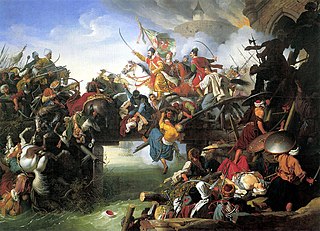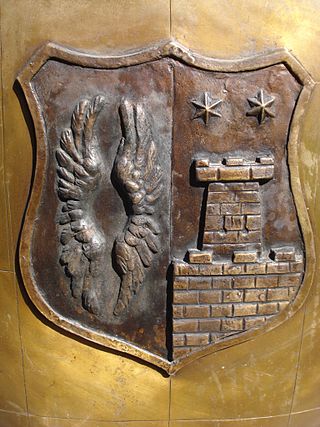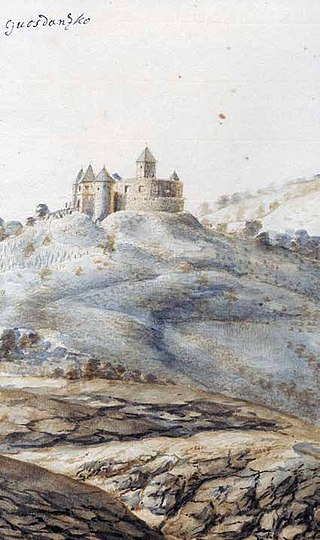
Nikola IV Zrinski or Miklós IV Zrínyi, also commonly known as Nikola Šubić Zrinski, was a Croatian nobleman and general, Ban of Croatia from 1542 until 1556, royal master of the treasury from 1557 until 1566, and a descendant of the Croatian noble families Zrinski and Kurjaković. During his lifetime the Zrinski family became the most powerful noble family in the Kingdom of Croatia.

The House of Frankopan, was a Croatian noble family, whose members were among the great landowner magnates and high officers of the Kingdom of Croatia in union with Hungary.

The siege of Szigetvár or the Battle of Szigeth was a siege of the fortress of Szigetvár, Kingdom of Hungary, that blocked Sultan Suleiman's line of advance towards Vienna in 1566. The battle was fought between the defending forces of the Habsburg monarchy under the leadership of Nikola IV Zrinski, former Ban of Croatia, and the invading Ottoman army under the nominal command of Sultan Suleiman the Magnificent.

Zrinski was a Croatian-Hungarian noble family, a cadet branch of the Croatian noble tribe of Šubić, influential during the period in history marked by the Ottoman wars in Europe in the Kingdom of Croatia's union with the Kingdom of Hungary and in the later Kingdom of Croatia as a part of the Habsburg monarchy. Notable members of this family were Bans of Croatia, considered national heroes in both Croatia and Hungary, and were particularly celebrated during the period of Romanticism, a movement which was called Zrinijada in Croatia.

Petar IV Zrinski was Ban of Croatia (Viceroy) from 1665 to 1670, general and a writer. A member of the Zrinski noble family, he was noted for his role in the attempted Croatian-Hungarian Magnate conspiracy to overthrow the Habsburgs, which ultimately led to his execution for high treason.

Ferhad Pasha Sokolović was an Ottoman general and statesman from Bosnia. He was the last sanjak-bey of Bosnia and first beylerbey of Bosnia.

Hrvatska Kostajnica, often just Kostajnica, is a small town in central Croatia. It is located on the Una river in the Sisak-Moslavina County, south of Petrinja and Sisak and across the river from Bosanska Kostajnica in Bosnia and Herzegovina.
The military history of Croatia encompasses wars, battles and all military actions fought on the territory of modern Croatia and the military history of the Croat people regardless of political geography.

Novi Zrin was a fortress of the Zrinski noble family built near the Donja Dubrava village in the northernmost part of Croatia on the mouth of river Mura into Drava between 1661 and 1664.

The Magnate conspiracy, also known as the Zrinski-Frankopan Conspiracy in Croatia, and Wesselényi conspiracy in Hungary, was a 17th-century attempt to throw off Habsburg and other foreign influences over Hungary and Croatia. The attempted coup was caused by the unpopular Peace of Vasvár, struck in 1664 between Holy Roman Emperor Leopold I and the Ottoman Empire. The poorly organized attempt at revolt gave the Habsburgs reason to clamp down on their opponents. It was named after Hungarian Count Ferenc Wesselényi, and by Croatian counts, brothers Nikola Zrinski and Petar Zrinski and Petar's brother-in-law Fran Krsto Frankopan.

Zrin Castle is a ruined castle located in the village of Zrin, south of the town of Sisak in Dvor municipality, central Croatia.

Čakovec Castle or Zrinski Castle is a medieval fortification in the middle of the town of Čakovec, the administrative seat of Međimurje County, northern Croatia.

Countess Ilona Zrínyi was a noblewoman and heroine. She was one of the last surviving members of the Croatian-Hungarian Zrinski/Zrínyi noble family. She was the daughter of Petar Zrinski, Ban (viceroy) of Croatia, the niece of both Miklós Zrínyi and Fran Krsto Frankopan and the wife of Francis Rákóczi I and Imre Thököly, as well as the mother of Francis Rákóczi II. She is remembered in history for her Defense of Palanok Castle against the Imperial army in 1685-1688, an act for which she was regarded a heroine in Hungary.

Nikola III Zrinski was a Croatian nobleman, a member of the Zrinski noble family, influential in the Kingdom of Croatia.

Miklós Zrínyi was a Croatian and Hungarian military leader, statesman and poet. He was a member of the House of Zrinski, a Croatian-Hungarian noble family. He is the author of the first epic poem, The Peril of Sziget, in Hungarian literature.

The siege of Gvozdansko was an Ottoman siege of the fort of Gvozdansko in the Kingdom of Croatia in 1577–1578. In the 1570s, the Ottomans intensified their efforts to capture the valley of the Una River. A string of forts along the Una, centred around Gvozdansko and in possession of the Zrinski noble family, formed the main line of defense of Croatia since 1527. The fort held off Ottoman attacks in 1540 and 1561.

The siege of Klis or Battle of Klis was a siege of Klis Fortress in the Kingdom of Croatia within Habsburg monarchy. The siege of the fortress, which lasted for more than two decades, and the final battle near Klis in 1537, were fought as a part of the Ottoman–Habsburg wars between the defending Croatian–Habsburg forces under the leadership of Croatian feudal lord Petar Kružić, and the attacking Ottoman army under the leadership of the Ottoman general Murat-beg Tardić.

The siege of Novi Zrin ; Croatian: Utvrda Novi Zrin; Hungarian: Új-Zrínyivár; Turkish: Zerinvar) in June/July 1664 was last of the military conflicts between the Croatian forces led by Nikola Zrinski, Ban (viceroy) of Croatia, and the Ottoman army commanded by Köprülü Fazıl Ahmed Pasha, Grand Vizier, dealing with possession of Novi Zrin Castle, defended by Croats, situated on the bank and marshy islands of Mura River, near the border line between northern Croatia and southwestern part of Hungary, at the time occupied by the Ottomans. The battle resulted in destruction of the castle, and retreat of the Croatian crew, which was forced to withdraw to safer territory of inland Croatia.

The Hungarian-Turkish Friendship Park is a public park in Csertő, southwestern Hungary, dedicated in memorial to the Battle of Szigetvár fought in 1566 between the Ottoman Empire and the Hungarian and Croatian defenders of the Szigetvár Castle. The park was established in 1994 and opened jointly by Hungarian and Turkish officials.

Franjo Frankopan Slunjski, was a Croatian nobleman from the branched Frankopan family in the 16th century. From 1567 until his death he served as Ban (Viceroy) of Croatia and was one of the most prominent figures of the fight against the Ottoman Turks and their expansion. Having been the last male descendant of the Slunj branch of the Frankopan family, he was called "the Sword and Shield of the Remnants of Illyria".



















